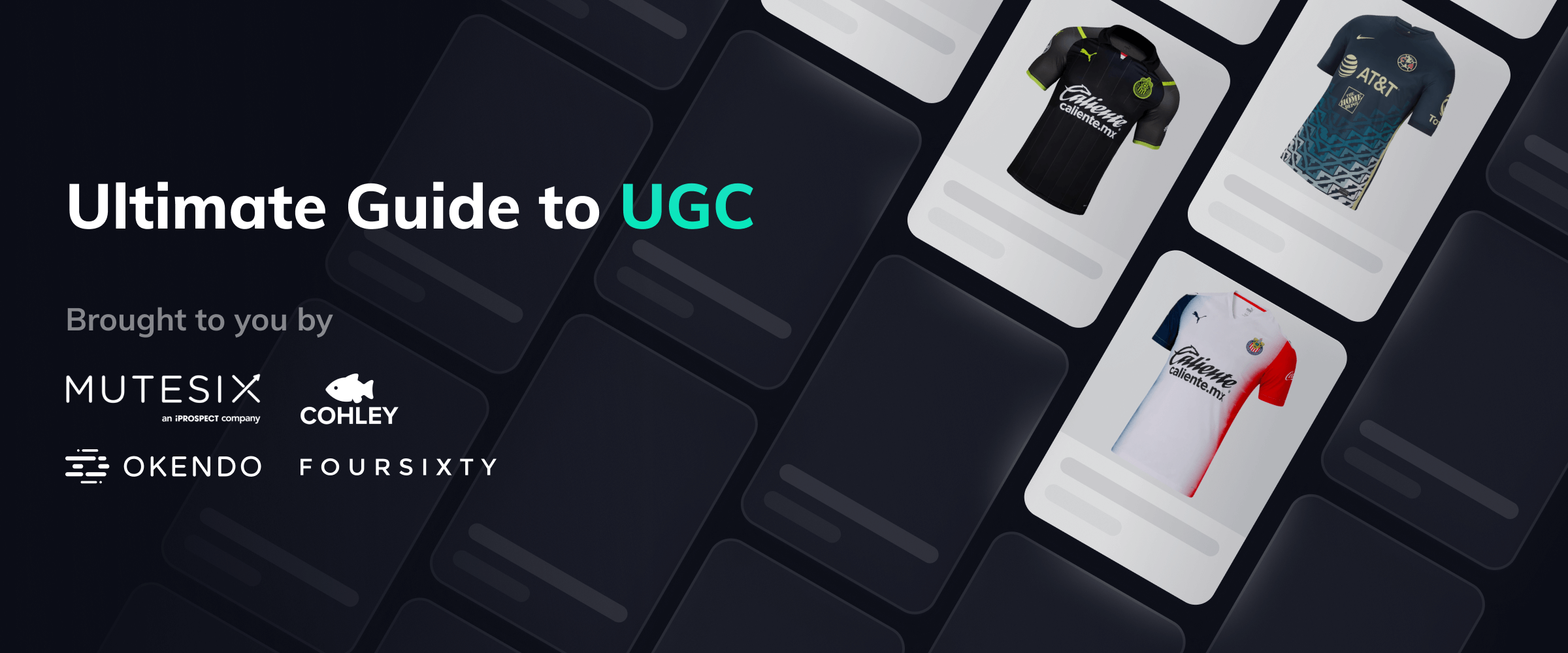The Ultimate Guide to UGC
Nov 2, 2021 | 19 minute read

Matt Goodman
Co-founder, CEO
User-generated content (UGC) is an increasingly important contributor to ecommerce success. UGC comes in many forms, and leveraging the unique advantages of each should form a cornerstone of your marketing strategy and brand positioning.
As consumers demand a closer connection to the brands that they shop with, UGC plays an important role in ensuring that your audience feels valued and represented. As more brands wake up to the potential of UGC to open (and strengthen) channels of communication and engagement, now is the time to ensure you’re taking full advantage of the opportunities on offer.
This guide will help to ensure that your business is fully up to speed and making the most of this valuable resource.
What is User Generated Content & Why Does it Matter?
UGC comes in many different forms (product photographs, videos, social media posts, even audio files), but shares one unifying factor – all content has been created exclusively by the brand’s customers.
Why is UGC so powerful? Two words: social proof. Simply put, we trust and value the opinions of our peers. Content that’s been generated by the customer has an additional layer of credibility that adds to the faith we feel in our purchasing decisions.
47% of the top-performing content marketing teams rely extensively on UGC to keep their pipeline filled. An estimated 90% of consumers claim that UGC holds more sway over their purchasing decisions than marketing emails and even search engine results. With 79% of people saying that UGC highly impacts their purchasing decisions, it’s easy to see why 42% of marketers regard UGC as a core component of their marketing strategy.
Why has UGC risen to such a place of prominence in modern ecommerce? Changes in consumer behavior. As social media’s popularity has increased, and become monetized via social commerce, the overlap of interested buyers and satisfied customers has naturally placed increased importance on referral to UGC.
The generation of UGC, and the way in which brands harness its power through marketing, will continue to evolve. New platforms such as TikTok, for example, have created entirely new formats of UGC (videos made with branded effects, hashtag challenges,etc) that we could not have conceived until recent years. Consumer behavior continues to adapt but the core principles, values and opportunities for brands remain the same.
What are the core advantages that online brands can gain from UGC?
- Highly Cost-Effective
The power of UGC is entirely in your customers’ hands – and as a result, content is generated for free. While brands don’t control the output, they benefit from a steady stream of highly individualized content that they can apply to their campaigns, websites and social feeds in any way they see fit. As a resource for keeping content output fresh and creative, UGC is hard to beat. Ads based on user generated content have been shown to attract a click through rate that’s 4 times higher and a 50% drop in cost-per-click compared to their traditional counterparts. - Extremely Persuasive
The psychology of UGC is fascinating, and largely centers around the concept of social proof. As social creatures, we instinctively trust and value the opinions and actions of our peers.
There’s a level of motive-free honesty that we lean into in terms of the content that our fellow customers choose to share. Free of marketing spin or any underlying objectives, UGC helps build authenticity. Millennials report that information gained through UGC is trusted 50% more than information from other media sources. - Great for Word of Mouth Marketing
Most marketers dream of the brands they manage forming part of their customers’ daily dialogue. Word of mouth marketing strategy isn’t just about going viral – there are far more achievable ways of getting into the hearts and minds of customers and their casual conversation.
UGC represents one of these approaches. By sharing relatable content, framed from the perspective of your existing customers, you open your brand up to casual discussion and engagement. 92% of consumers claim to trust word-of-mouth or recommendations more than any other form of advertising. - Better Customer Connection
Brands can use the post-purchase window to strengthen relationships – seeking the customer’s opinion and feedback and responding to their comments or content that they’ve taken the time to share. Making good use of the UGC that your customers create shows that your brand is invested in them and their ongoing experience, helping them to feel listened to and represented. - Proven to Be Effective
UGC aids sales. An impressive 70% of consumers will consult UGC reviews or ratings before making a decision to purchase. At least 41% of consumers will read between four to seven UGC reviews to gain better knowledge of a product that they’re interested in. Ads featuring UGC garnered 73% more positive comments on social networks than traditional ads.
Types of User-Generated Content

Michael Chachula
Founder & CEO
Photo Content
From snaps of new purchases through to selfies featuring a distinctive festive red coffee cup – product placement, whether conscious or unintentional, is rife within our daily photography habits.
Many brands will populate their entire Instagram feed output with UGC, where others will share UGC on such a regular cadence that a certain “style” evolves amongst its customers, as people (consciously or unconsciously) replicate the look and feel of content that has been previously shared. Starbucks provides a great example of this – photos of hands holding their beverages up against colorful backgrounds are a motif that repeats consistently throughout their Instagram feed.
Earning high engagement and wide appeal to lots of demographics and audiences, there are many ways that brands can use images generated by their customers on social media to their best advantage. Being responsive, good use of hashtags, and the use of a well-defined brand voice all create opportunities for engagement around these images.
Product photography generated on social media can be a valuable asset to other platforms. Many brands benefit from pulling highlights of their social feeds to help populate and enhance the product pages of their ecommerce stores. Foursixty helps brands perfect this tactic, creating shoppable galleries for your online store, email and other channels, tracking creators and gifting programs, helping to secure the rights to UGC, and delivering advanced Instagram insights and analytics.
Video Content
Popular content sharing platforms such as TikTok and YouTube provide a natural outlet for this kind of UGC, and the chosen platform will often dictate the kind of content that is produced. Google estimates that 50,000+ hours of product review YouTube videos were watched on mobile devices alone in the past two years.
YouTube for example is well known for the huge popularity of “haul” type videos, in which content creators share the purchases they’ve made on a particular shopping trip, talking through each item in detail and giving their opinions. “Unboxing” videos are another popular trope, with customers filming the process of unpacking a delivery and giving their first impression of their purchase.
User generated video content tends to give a high level of detail, and this is very valuable in terms of helping make purchase decisions. Video content is also known to perform well in terms of engagement, so there’s the potential for brands to enjoy higher levels of visibility.
Brands looking to make the most of video related UGC should be sure to pay attention to their full customer experience – people making content of this kind are just as likely to report on the fulfillment processes and post-purchase messaging as they are the actual product.
Showcasing video content within your site can be highly beneficial, as customers love to turn to these kinds of engaging and honest reviews to help them make up their minds regarding a product.
Reviews
Nothing comes close to the power of the customer review. In fact, 76% of consumers say they trust the reviews they read online as much as personal recommendations.
As well as influencing purchase decisions, integrating reviews into the design of your web store can create a sense of community, with fans of the brand sharing their own tips and takes on certain products. It’s this kind of relatable, personal content that helps foster better brand loyalty and approval. Okendo helps brands integrate reviews in a wide variety of customizable displays, complementing the existing store design.
A very adaptable form of UGC, reviews can be leveraged across more than owned ecommerce sites. They also provide fantastic content for advertisements, shoring up a brand’s claims with added authenticity. Additionally, star ratings can be a beneficial addition to PPC advertising on channels such as Google Shopping, where a clear star rating can help your product listing stand out from competitors. One study found that 94% of online purchases are made for products with an average rating of either four or five stars.
Reviews can also be woven into email marketing campaigns – Okendo’s integration with Klaviyo makes this process seamless and helps brands harness the insight that can be gained from the wide range of customer data that reviews provide.
Be transparent, responsive and use the data generated to your best advantage for improvements to your continued marketing and product development.
UGC is in a constant state of evolution. Brands need to stay aware of emerging trends and opportunities. The rise and fall of different social platforms will see the popularity of various trends ebb and flow accordingly. Right now, we’re seeing a shift towards TikTok & Instagram Reels, for instance. The smartest ecommerce brands will adopt a flexible mindset, adjusting their strategy to accommodate these changes as they emerge.
UGC Best Practices

Tom Logan
Co-Founder & CEO
There’s a lot to be gained from the savvy application of UGC to your brand’s marketing strategy. However, there are also some challenges to remain mindful of in order to achieve best results.
Poor Quality UGC
When gathering UGC, content that is detailed and rich in various forms is ideal. Of course, even something as simple as a star rating has its place, and can be useful – but if you’re able to collect a wider range of UGC you’ll see a much more pronounced positive impact.
Best practices to prevent this?
- Although quality is subjective, we do understand that a lot of visual UGC is simply unusable (such as blurry or dark photos, for example). While it can be beneficial to occasionally test content that feels a little outside of your brand’s comfort zone, be sure to provide sample content to your audience as a standard to live up to and be inspired by.
- Incentivize the inclusion of more forms of UGC by offering discount codes or exclusive products to customers who, for example, include images or videos in the reviews they produce, in addition to the review itself.
A Fear of Bad Reviews
While most brands would hope for any negative reviews to be minimal, there’s actually a case to be made for the occasional lower star rating or criticism. Instead of burying these, tackle them head-on, with transparency. If your site showcases only glowing reviews, things can look disingenuous and a little too good to be true.
Best practices to prevent this?
- Embrace negative reviews but make it standard practice to ensure they are all followed up with a public response, addressing the issue, apologizing where appropriate and making it clear what action will be taken as a result.
- Learn from your reviews – product development and improvement can be fueled by digging into review data to search for common themes and issues.
Low Levels of UGC
How much UGC is enough? One thing’s for certain – you’ll never find yourself wishing you had less. For some, a steady stream of Instagram images may be required to help populate their feed. Others might be striving to collect more reviews (it’s been said that between 20 and 50 reviews represent a sweet spot in terms of winning consumer trust.)
Best practices to prevent this?
- Have a strategy for proactively encouraging the kind of content you’re seeking more of – e.g running contests, creating hashtag challenges, scheduling regular “customer content” spotlight features. Get creative, and your customers will too.
- Ask for UGC in a timely manner, and give your audience the prompts they need to create the kind of content you’re hoping for. In the case of reviews, the best results can be achieved by leveraging a specific post-purchase request flow, via a tool such as Okendo’s Sequences.
Copyright issues
While it is, of course, important to ensure you’re only using the UGC that you have permission to share, this shouldn’t be a barrier to the opportunity at stake.
Best practices to prevent this?
- Get to know the difference between implicit and explicit permission – and always seek the latter. Working with a platform such as Cohley removes all doubt from the process.
- When in doubt, ask directly. If you’re looking to share an Instagram post, comment publicly on the post in question. Many brands choose to request that the content creator responds by typing a specific phrase or hashtag, leaving no margin for error that permission has been granted.
Dubious authenticity
While UGC is generally seen to be much more authentic and genuine than content coming directly from a brand, you’ll still want to take all reasonable measures to ensure that you’re keeping your feeds and stores full of content that inspires real trust in your products.
Best practices to prevent this?
- Don’t shy away from including anything that’s less than glowing. A perfect score of 5 stars from each and every customer doesn’t look impressive – it looks suspicious!
- Most people can smell brand inauthenticity from a mile away. Counteract this by encouraging your audience to create only what truly inspires them and allow their personality shine through.
Lack of scalability
Building up UGC for use across your website and marketing channels can be hard to scale if you don’t have the necessary tools or processes in place. If you are successful in generating a lot of content, you may find yourself struggling to moderate or make the best use of the UGC you have access to.
Best practices to prevent this?
- Invest in solutions that can help to triage your incoming UGC. Whether this is Okendo’s streamlined review generation process, or a carefully constructed campaign being strategically filled by content creators via Cohley, the right technical tool to help you keep on top of your growing brand’s content is out there.
How to Integrate User-Generated Content Into Your Ecommerce Marketing Strategy

Moody Nashawaty
Chief Strategy Officer
There’s much to be gained from leveraging UGC across the full range of paid ads and owned digital channels, as an integral part of your wider marketing strategy. 81% of shoppers have reported that they are willing to pay more and wait longer for products paired with UGC, and nearly two-thirds of shoppers (63%) believe UGC creates a more authentic shopping experience.
With 90% of consumers saying UGC holds more influence over their buying decisions than even search engine results, we recommend that you take a holistic approach to the way that you integrate this rich source of content in your marketing strategies.
Email Marketing
Email marketing is already known to be a highly effective tactic for obtaining great ROI (often claimed to be as high as 4400%!) UGC can add to this in a variety of different ways, helping brands double down on a tactic that’s already getting good results.
UGC can add social proof to email campaigns that need an extra dose of persuasive power. Sitka Salmon Shares provide a great example of the way that UGC can be used to enhance marketing emails, enhancing brand position and strengthening the underpinning campaign message.
UGC can be leveraged in a wide range of email campaigns:
- Welcome emails – give new shoppers a warm welcome that reflects your brand’s wider community, with the inclusion of a range of customer images.
- Abandoned cart emails – claw back sales with proof of your products’ quality, including some rave reviews or video testimonials.
- Post-purchase emails – thank your customers for shopping with you and ask for their valued feedback, making them feel valued and respected.
- Reengagement emails – entice customers back to the fold with a wide spectrum of UGC to show them just what they’re missing out on.
UGC can help your products stand out in the competitive wilderness of Google’s search results pages. This is a high-stakes area of ecommerce where every small advantage counts.
Enhanced Product Listing ads (those which are illustrated with images and include product title, price, store name, etc.) have been shown to convert at a 30% higher rate than their equivalent text ads on desktops – so it pays to ensure that the content you’re enhancing these adverts with is as authentic and compelling as possible.
Here are some of the ways that UGC can help get your products noticed on Google Shopping.
- Google Shopping Ads – help to ensure that the traffic clicking through on these listings is well qualified by providing as much contextual information as possible.
- Product Listing Ads – benefit from the display of a seller rating. A minimum of 50 on-site product reviews are needed before you can apply for a star rating to be attached to your product listings – so work with a partner like Okendo. Merchants using Okendo generate an average of 3.4x more reviews.
Social Media Marketing
When looking to make the most productive use of social media, brands should consider the full spectrum of ways they can lean on the creativity of their customers to generate inspiring content, especially with regard to paid campaigns.
One of the most beneficial elements of this strategy is the authenticity that UGC can lend to social output. The vast majority of consumers (86%) claim that authenticity is an important factor when deciding which brands they like and purchase from. Among Millennials, that number climbs to 90%. 60% of people view UGC as the most authentic form of content.
Shoppers were found to be three times more likely to view content created by a consumer as authentic, compared to content created by a brand.
Here are some of the ways that a brand’s reputation can benefit from the inclusion of UGC within its social marketing.
- Paid Ads – temper the paid nature of your social media advertisements with user-generated video or imagery, or deploy testimonials taken directly from your most glowing reviews.
- Influencer Collaborations – work with influencers to create a more curated form of UGC that will have very specific and targeted appeal to a certain following. Influencer UGC is incredibly effective, delivering a 20% boost to ROAS when integrated into advertising campaigns.
- Brand takeovers – letting influential customers take the reins of your social channel for a set period of time can have a great impact on visibility.
How to Collect User Generated Content

Lindsay Kolinsky
Partner Marketing Manager
Your UGC generation strategy needs to be reliable and consistent in its ability to pull in a steady stream of suitable content that you can leverage across all channels. Without a solid strategy, you’ll be left lacking – scrambling to make the most of content which is either sub-par, or simply not plentiful enough.
Thankfully, several solutions exist to help ensure that brands like yours can obtain both the quality and quality of UGC required. Let’s explore some of the core forms of collection.
Outreach by email is usually integrated into the post-purchase process.
Tips for best practice:
- Automate the process and time your requests. If you’re asking for content that relates to the products that they’ve just purchased, then make sure they’ve had enough opportunity to truly experience the product. Factor in delivery time too.
- Offer rewards and incentives. The promise of a free sample or promotional code as a reward that features images or video footage will often be enough to ensure you get the response you’re hoping for.
- Keep communication personal and on-brand when making your request.
- Integrate customer support – if you’re reaching out to request a review, it’s a great time to ensure any issues are flagged and resolved swiftly.
- For more pointers on how to successfully request reviews via email, head here.
Social Media
Encouraging your audience to participate and engage with your social media profiles is essential for building a community spirit that will see content creators leaning into your brand.
Tips for best practice:
- Be active and aware – great content moves fast on social media, capture it while it’s relevant and have a plan in place to ensure that content is used within a suitable time frame (especially with regard to seasons, the launch of new collections, holidays, etc – content can date fast so don’t horde it!)
- Use an aggregation engine like Foursixty to keep track of everything that is being generated – it’s important to have a good overview of what’s being produced so that you can make the best use of your highest quality UGC.
- Keep on top of digital rights – don’t forget that consent to repurpose UGC must be given. Again Foursixty is able to help, offering a full digital rights management system to request, acquire and store the rights to customer-generated photos and videos.
- Use in combination with review data for maximum impact – UGC from social media and reviews can be blended together in dynamic galleries, perfect for populating product pages.
SMS
This OG comms channel has a lot to offer the savvy marketer who’s ready to put the work into honing their approach and strategy.
Tips for best practice:
- Keep things personal and respectful – this is an intimate form of communication and customers will expect a personalized form of contact.
- Don’t overuse the medium. The engagement statistics for SMS are impressive: 90% open rates can be expected, 35%+ click-through rates are common and engagement rates are often 6-7x times higher than email. But don’t get greedy – a light touch for this very direct line of communication should be your default.
- Use SMS as part of a broader content generation strategy, at the optimum moment. Okendo’s integration with Postscript and the functionality of Sequences make review requests easy.
UGC: A World of Opportunity
The opportunity that UGC represents to eCommerce brands is vast. As our use of social media increases and we look to become ever closer and better connected to the brands that we love, this opportunity is only set to increase.
UGC bridges the gap between brand and consumer and helps each get a better understanding of the other.
Okendo offers the ideal platform for a 360-degree approach to UGC, from initial generation to effective integration in campaigns, assisted and enhanced by a range of powerful partner integrations.
Ready to learn more?